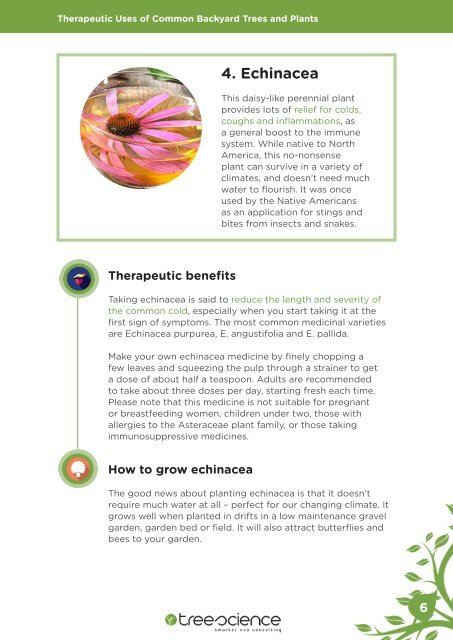Tree Science eBook - Therapeutic Uses of Common Backyard Trees and Plants
You also want an ePaper? Increase the reach of your titles
YUMPU automatically turns print PDFs into web optimized ePapers that Google loves.
<strong>Therapeutic</strong> <strong>Uses</strong> <strong>of</strong> <strong>Common</strong> <strong>Backyard</strong> <strong>Tree</strong>s <strong>and</strong> <strong>Plants</strong><br />
4. Echinacea<br />
This daisy-like perennial plant<br />
provides lots <strong>of</strong> relief for colds,<br />
coughs <strong>and</strong> inflammations, as<br />
a general boost to the immune<br />
system. While native to North<br />
America, this no-nonsense<br />
plant can survive in a variety <strong>of</strong><br />
climates, <strong>and</strong> doesn’t need much<br />
water to flourish. It was once<br />
used by the Native Americans<br />
as an application for stings <strong>and</strong><br />
bites from insects <strong>and</strong> snakes.<br />
<strong>Therapeutic</strong> benefits<br />
Taking echinacea is said to reduce the length <strong>and</strong> severity <strong>of</strong><br />
the common cold, especially when you start taking it at the<br />
first sign <strong>of</strong> symptoms. The most common medicinal varieties<br />
are Echinacea purpurea, E. angustifolia <strong>and</strong> E. pallida.<br />
Make your own echinacea medicine by finely chopping a<br />
few leaves <strong>and</strong> squeezing the pulp through a strainer to get<br />
a dose <strong>of</strong> about half a teaspoon. Adults are recommended<br />
to take about three doses per day, starting fresh each time.<br />
Please note that this medicine is not suitable for pregnant<br />
or breastfeeding women, children under two, those with<br />
allergies to the Asteraceae plant family, or those taking<br />
immunosuppressive medicines.<br />
How to grow echinacea<br />
The good news about planting echinacea is that it doesn’t<br />
require much water at all – perfect for our changing climate. It<br />
grows well when planted in drifts in a low maintenance gravel<br />
garden, garden bed or field. It will also attract butterflies <strong>and</strong><br />
bees to your garden.<br />
6


